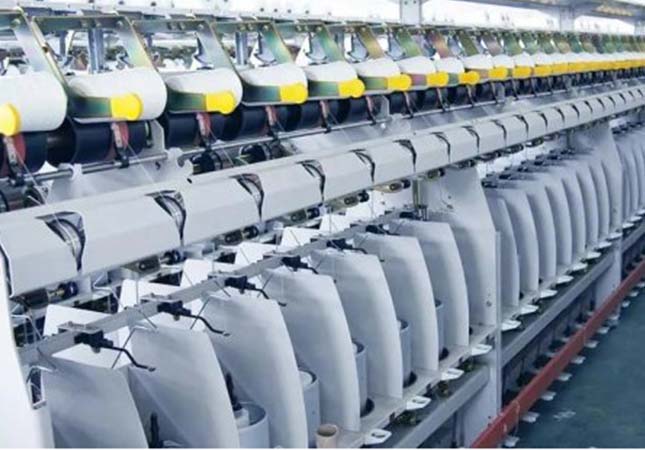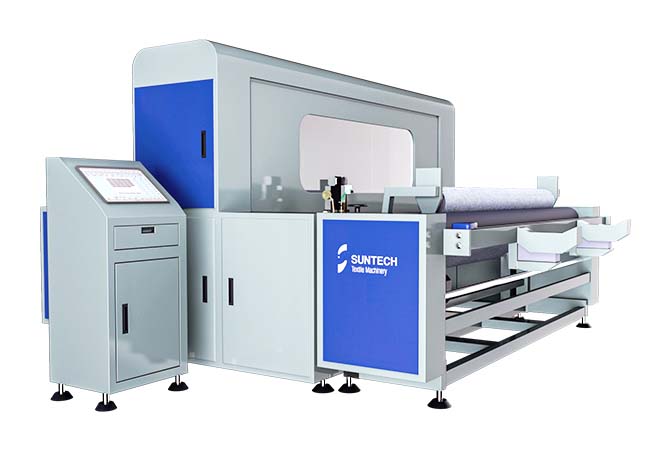The usage of inspection machine is to help the manufacturers to detect defects in fabrics so that manufacturers could take corrective measures to address the issues and ensure that their textiles meet the desired quality standards.

How Inspection Machine Help in Detecting Defects
Here are some ways in which inspection machine help in detecting defects:
1. Visual Inspection
Inspection machine uses advanced imaging technologies, such as high-resolution cameras and sensors, to visually inspect fabrics for defects. These machines capture images of the fabric surface and analyze them in real time to identify any visible defects, such as stains, holes, snags, pilling, color variations, and printing defects. The high-resolution images allow for a detailed examination of the fabric, enabling the detection of even small defects that may not be visible to the naked eye.
2. Automated Defect Detection
The modern inspection machine is equipped with automated defect detection algorithms that can identify defects based on predefined criteria. These algorithms analyze the fabric images captured by the machine and compare them against the reference images or predefined defect templates to identify defects accurately. The algorithms can be trained to detect various types of defects, including fabric distortions, pattern irregularities, printing defects, and other visual inconsistencies.
3. Real-time Monitoring
The inspection machine provides real-time monitoring of the fabric inspection process, allowing operators to immediately detect and address any defects or irregularities. As the fabric is fed through the machine, it is continuously inspected, and any defects or irregularities are highlighted on the operator's interface for prompt action. This enables manufacturers to quickly identify and rectify defects, preventing them from being incorporated into the final product, thus reducing the risk of producing defective textiles.
4. Statistical Analysis
The inspection machine also performs statistical analysis of fabric defects, providing manufacturers with valuable data on defect types, frequencies, and trends. This data can be used for process optimization, quality improvement, and root cause analysis. By analyzing the defect data, manufacturers can identify patterns or trends that may indicate issues in the fabric production process, machine settings, or other factors affecting fabric quality. This allows for proactive measures to be taken to address the root causes of defects, resulting in improved overall product quality.
5. Flexibility in Defect Detection
Inspection machine offers flexibility in detecting defects based on the specific requirements of the manufacturer or customer. These machines can be configured to detect defects based on different criteria, such as defect size, shape, location, or severity. This flexibility allows manufacturers to customize the inspection process according to their unique needs and product specifications. Manufacturers can set different defect thresholds, adjust inspection parameters, and define defect classifications to suit their specific quality standards, ensuring that only fabrics meeting their quality criteria are used in their products.
6. High-speed Inspection
The inspection machine is capable of high-speed inspection, enabling manufacturers to inspect fabrics at a significantly faster rate compared to manual inspection methods. These machines can handle large volumes of fabric rolls and can inspect fabrics at speeds ranging from several meters to hundreds of meters per minute, depending on the machine's capabilities. This high-speed inspection allows for efficient and productive fabric inspection processes, reducing inspection time and labor costs while maintaining high levels of accuracy.
7. Reduced Human Error
The inspection machine eliminates or reduces the human error factor associated with manual inspection. Human inspectors are prone to fatigue, distractions, and subjective judgments, which can result in inconsistencies in defect detection. On the other hand, inspection machine operates with high precision and consistency, ensuring reliable and accurate defect detection. This reduces the risk of human error and ensures that defects are detected consistently and reliably, resulting in improved product quality.
8. Documentation and Reporting
Inspection machine typically provides documentation and reporting capabilities that enable manufacturers to keep track of the inspection results and generate.

How Manufacturers Can Take Corrective Measures to Ensure High-quality Textiles
Manufacturers in the textile industry understand the importance of producing high-quality textiles to meet customer requirements, maintain a strong market position, and ensure customer satisfaction. Here are some ways in which manufacturers can take corrective measures to ensure high-quality textiles.
1. Identify the Root Causes of Defects
When fabric defects are detected, it is essential to identify the root causes of the defects. This can involve investigating the production process, analyzing machine settings, reviewing raw material quality, or identifying other factors that may have contributed to the defects. By identifying the root causes of defects, manufacturers can take targeted corrective actions to address the issues and prevent similar defects from occurring in the future.
2. Review the Production Process
Manufacturers should review the entire production process, from raw material handling to finished product packaging, to identify any potential areas for improvement. This can involve analyzing each step of the production process, including spinning, weaving/knitting, dyeing, printing, finishing, and cutting, to ensure that best practices are being followed. Any deviations from standard operating procedures (SOPs) or process parameters should be identified and addressed to ensure the consistent production of high-quality textiles.
3. Optimize Machine Settings
Manufacturers should review the machine settings of fabric production machinery, such as looms, knitting machines, dyeing machines, and printing machines, to ensure that they are optimized for producing high-quality textiles. Machine settings, such as tension, speed, temperature, and pressure, can significantly impact fabric quality. Adjustments to machine settings may be necessary to address defects and ensure that the fabric is produced according to the desired quality standards.
4. Monitor Raw Material Quality
Raw materials, such as yarns, dyes, chemicals, and other additives, can have a significant impact on fabric quality. Manufacturers should monitor the quality of raw materials used in the production process to ensure that they meet the required specifications. This may involve conducting regular tests and inspections of incoming raw materials, maintaining a good relationship with suppliers, and ensuring that only approved raw materials are used in the production process.
5. Implement Quality Control Measures
Manufacturers should implement robust quality control measures at various stages of the production process to detect and address defects early in the process. This can involve conducting in-process inspections, random sampling, and final inspections of finished textiles to ensure that they meet the desired quality standards. Quality control measures should be documented and followed consistently, and any deviations from standards should be addressed immediately.
6. Train and Educate the Workforce
The workforce plays a critical role in ensuring the production of high-quality textiles. Manufacturers should invest in training and educating their workforce on best practices, quality standards, and defect detection techniques. Properly trained and knowledgeable workers are better equipped to detect and address defects during the production process, reducing the risk of producing defective textiles. Regular training programs, workshops, and knowledge-sharing sessions can help ensure that the workforce is skilled and updated with the latest industry practices.
7. Implement Continuous Improvement Strategies
Manufacturers should embrace a culture of continuous improvement and constantly strive to identify and implement improvements in the production process. This can involve regular reviews of production data, analyzing defect trends, conducting root cause analysis, and implementing corrective and preventive actions (CAPAs). Continuous improvement strategies can help identify areas for improvement, address process inefficiencies, and optimize production processes to ensure consistent production of high-quality textiles.
8. Collaborate with Suppliers and Customers
Collaborating with suppliers and customers can be beneficial in ensuring high-quality textiles. Manufacturers should work closely with their suppliers to ensure the timely delivery of high-quality raw materials and address any quality issues proactively.
SUNTEC ST-TFIM Tubular Fabric Inspection Machine ( Single Pass Checking )
Here are something about the SUNTEC ST-TFIM tubular fabric inspection machine.
1. Fabric Rolling Drawer
The Upper Delivery Mode reduces fabric tension, making it more convenient for inspection.
Ensures smooth fabric rolling and handling during the inspection process.
2. Controllable Inspecting Speed
The inspecting speed can be easily controlled using an inverter as per specific requirements.
Provides flexibility in adjusting the speed for different fabric types or inspection needs.
3. High Voltage Dispenser for Lightening System
This specialized device provides wireless electricity power to the fabric checking box, ensuring efficient and safe operation.
Eliminates the need for cumbersome wiring, enhancing convenience and safety.
4. Multi-size Inspecting Lightening Cabinets
Accommodates various fabric widths ranging from 18" to 50" as per the requirements of different fabric types.
Equipped with magnetic blocks in the bottom to automatically suspend against the roller, preventing crease marks on the fabric.
5. 2 Modes of Fabric Layout
Provides options for fabric layout, either rolling or plaiting, based on specific preferences or requirements.
Offers versatility in fabric handling during the inspection process.
6. Easy Operation Panel
Features a simple and user-friendly panel with only a few push buttons for smooth machine operation.
Reduces complexity and facilitates easy operation for the user.
7. Remote Foot Pedal
Enables more convenient and hands-free operation with a remote foot pedal.
Enhances ease of operation during fabric inspection, reducing physical strain.
Conclusion
The inspection machine plays an important role in ensuring the quality of the fabrics and is a must for the manufacturers of the garments. With its advanced features, superior performance, and user-friendly design, the SUNTTECH ST-TFIM offers a high-quality solution for fabric inspection in the textile industry.




